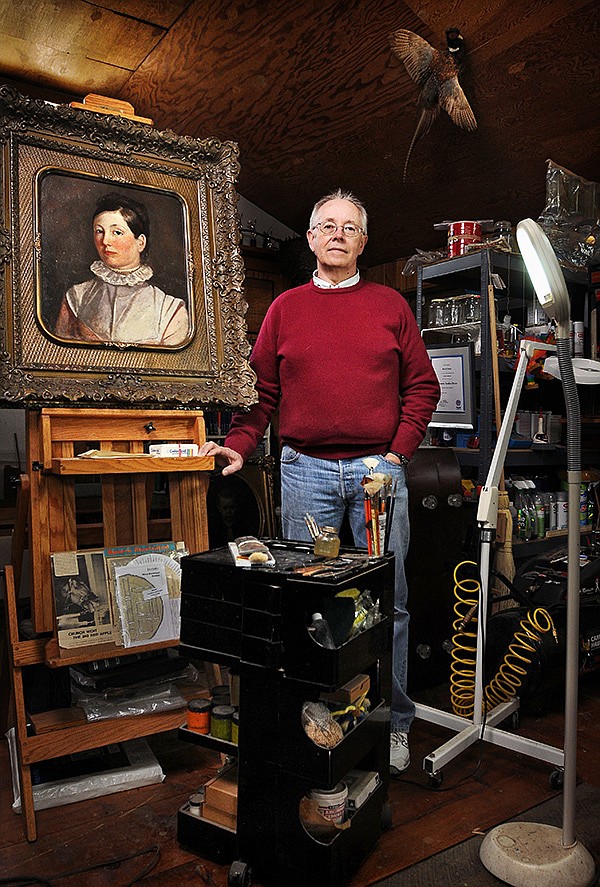Trip to Cuba a bid to save the old
Conservator fears island’s historic places, relics at risk
NWA Media/BEN GOFF Conservator Rick Parker poses for a photo with one of his restoration projects, a painting by Samuel Morse that dates to around 1840, on Wednesday in his workshop in Gentry. Parker, who recently returned from Cuba surveying United Nations World Heritage sites, is a private conservator on staff with the Smithsonian Institution who specializes in restoring wooden artifacts.
Monday, March 31, 2014
GENTRY — It’s the humidity in Cuba that worries Rick Parker.
That and the termites.
The island is running low on native cedar and mahogany, and the termites devour pretty much everything else, said Parker.
Parker, who lives in Gentry, is an expert on the conservation of wooden artifacts, paintings and gold gilding. He’s a private conservator for the Smithsonian Institution.
In January, Parker was one of a dozen conservators who went to Cuba to inspect UNESCO World Heritage sites. They were looking for ways to help the Cuban government preserve these places.
UNESCO is the United Nations Educational, Scientific and Cultural Organization. It was founded in 1945 and is based in Paris.
The organization came up with the idea of the World Heritage designation to protect sites of “outstanding universal value,” according to unesco.org.
Parker advised the Cubans that modern consolidants could help protect wooden artifacts. Consolidants, or hardeners, are usually resins that have been dissolved in a solvent.
“We’ve gotten so used to having everything at our fingertips,” said Parker. “They just don’t have it. They’re getting it, but it’s a much slower process, and it’s expensive.”
Many things about the island seem stuck in 1960, when the U.S. imposed an embargo in the aftermath of the revolution that put Fidel Castro in power. Visitors often return from Cuba withphotos of American-made cars from the 1950s. Travel to Cuba is still restricted for U.S. tourists, but hundreds of thousands of people travel from the U.S. to Cuba every year.
Cuba has nine World Heritage sites, according to unesco.org. Three more sites have been nominated and are on the “tentative” list. Parker’s group toured most of the sites, in addition to other points of interest like San Juan Hill and Ernest Hemingway’s house near Havana. Cuba’s World Heritage sites are listed at whc.unesco.org/ en/statesparties/CU.
Parker said he was selected to go to Cuba after presenting a paper last year at a convention of the American Institute for Conservation of Historic and Artistic Works in Indianapolis. The paper’s topic was a project in which Parker built a replica of a 4,000-year-old table, made from photos, drawings and measurements from a tomb in Turkey.
“The table I fabricated is made of absolutely extinct wood from New Zealand that is 40,000 to 60,000 years old and the finish is made from resin also that old found in the wood,” Parker said. “It’s basically tree sap from the wood.”
Everyone who went on the trip to Cuba was affiliated with the conservation institute. Parker, a former chairman of the institute, said it was an honor for a conservator from Arkansas to be chosen to go on the trip.The travelers left Jan. 23 and returned Feb. 5.
When they got to Cuba, Parker said, he learned there were no microscopes available to examine paintings and other artifacts.
“It’s pretty much standard practice back here,” said Parker. “They do have microscopes. They just don’t use them in art preservation like we do.”
Parker said he told conservators in Cuba about digital microscopes, which plug directly into laptop computers and would make the work easier.
On the first day in Cuba, the group toured Castillo de San Pedro de la Roca, known locally as El Morro. It’s a 16th-century fortress on the Bay of Santiago.
“Inscribed to the UNESCO World Heritage list in 1997, it is considered the best preserved example of Spanish New World military installations as based on Renaissance principles,” according to a diary of the trip on the institute’s website, conservation-us.org.
Other excursions in Cuba included Camaguey, a World Heritage city founded in 1528.
“Sacked by the pirate Henry Morgan in the 17th century, an effort was made to confuse future marauders by rebuilding the city with an unusual labyrinthine city plan …,” according to the travel diary.
Parker cleaned the 16th-century gold altar in the Cathedral of Camaguey.
“It basically had a lot of surface dirt on it,” he said.
Parker also examined the house in Santiago where Diego Velazquez de Cuellar lived. Velazquez was a Spanish conquistador who governed Cuba. Built in 1520, the house is the oldest in Cuba, said Parker.
Parker also examined about 30 paintings and murals during the trip.
Back home in Arkansas, Parker does most of his work from his shop in Gentry. At one point in October, paintings by Vincent Van Gogh, Pierre-Auguste Renoir and Eugene Delacroix were in his shop, all in need of repair or restoration.
Several tails from red fox squirrels were on the counter in Parker’s shop during a recent interview. They’re the “Ferrari of gilding tips,” he said. The fine hairs of the fox squirrel tail are the best for picking up minute gold flecks to transfer to other surfaces.
“The English and Europeans have these black squirrels they use now, and their tails don’t work worth a plug nickel,” said Parker.
Parker said a womancalled the police on him once because she saw him in the street hacking the tail off a dead fox squirrel with a hatchet. The woman apparently didn’t know the squirrel was dead when Parker found it.
Parker said papers from the Cuba trip will be presented at the institute’s May 2015 meeting in Miami.
Northwest Arkansas, Pages 7 on 03/31/2014
